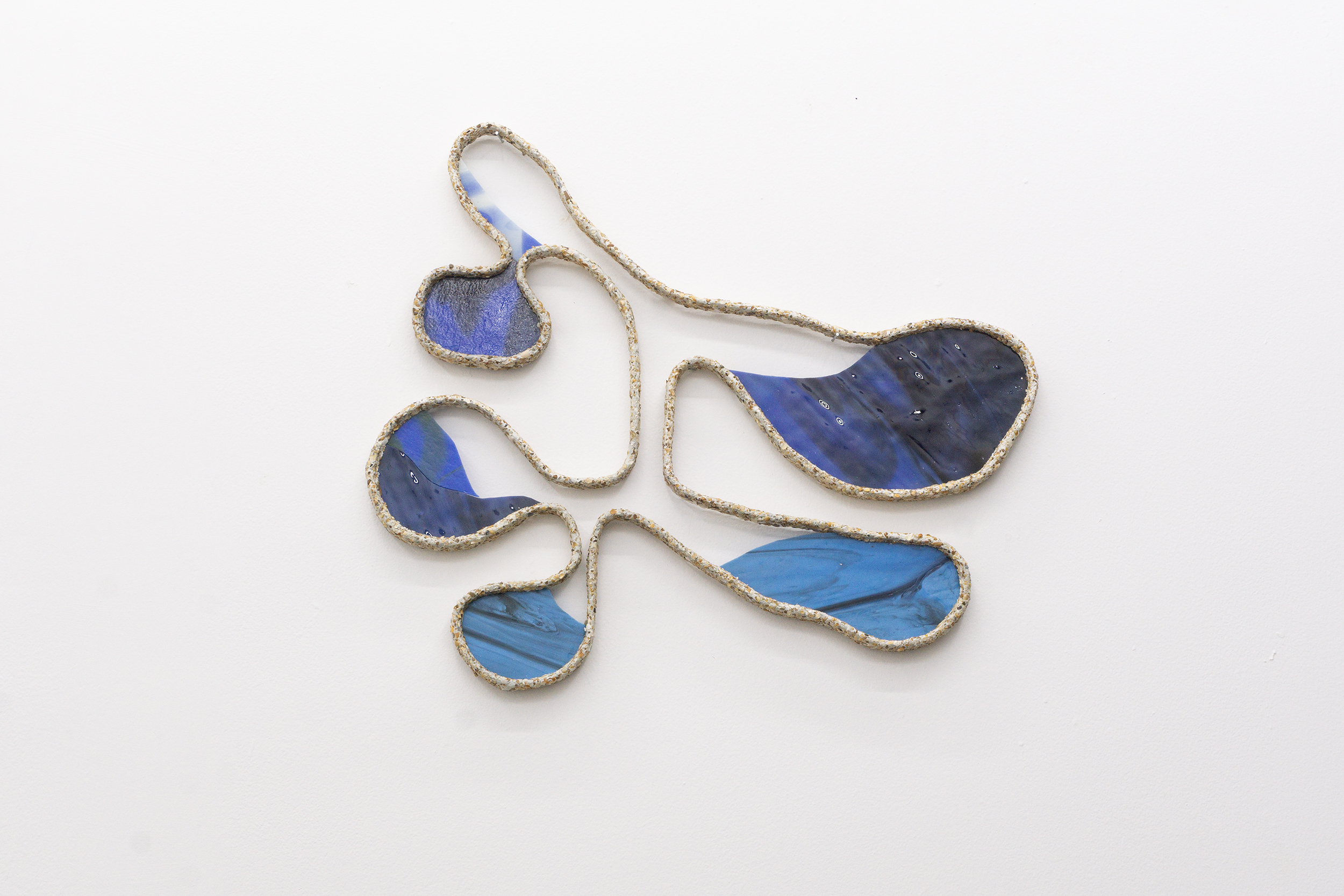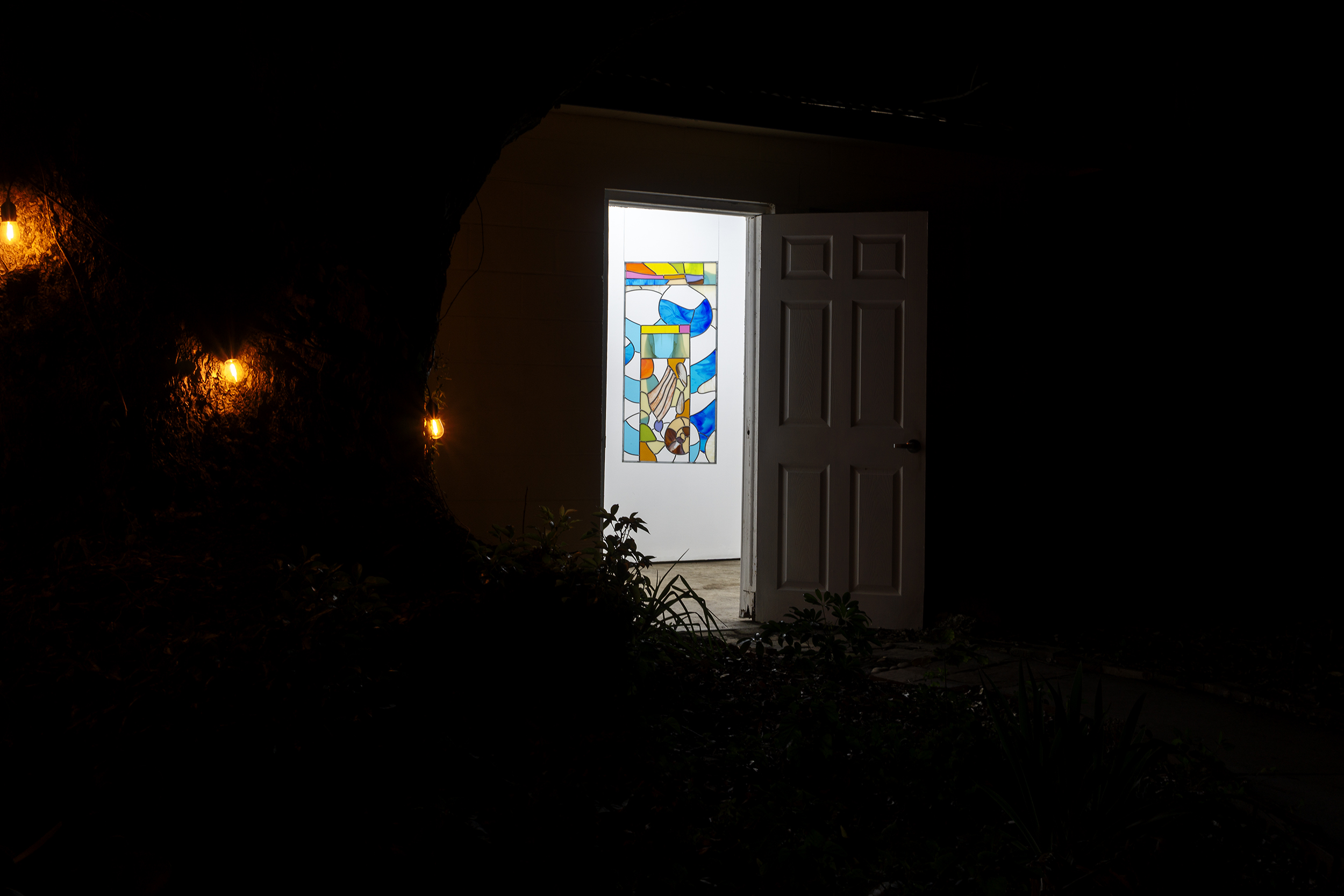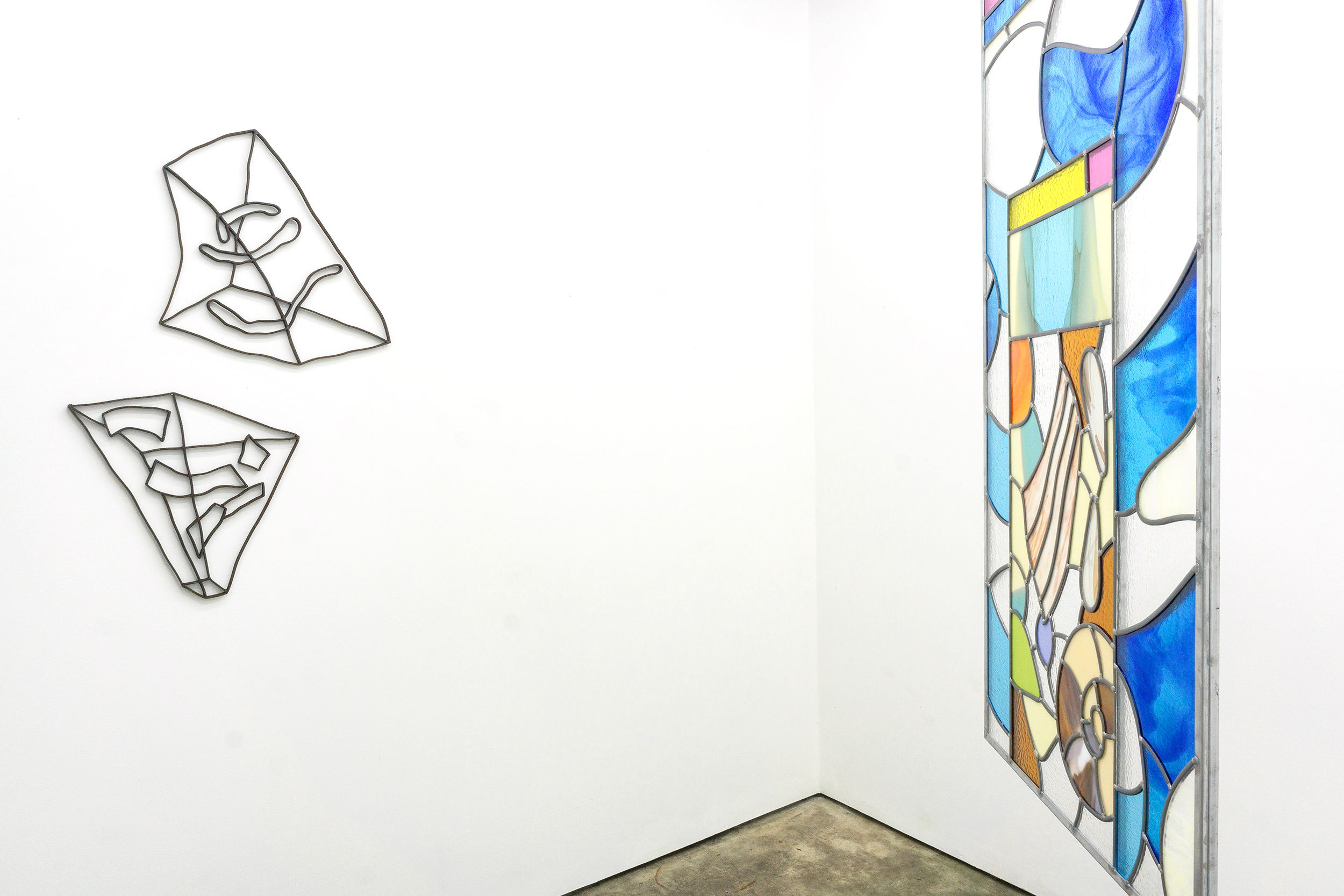a solo exhibition featuring the work of Devin Balara
opens Saturday, Jan 13, 2024 with an opening reception 7-10pm;
the exhibition runs through May 4, 2024
304 w Crest Ave, Tampa, FL 33603

an interview with the artist by Erin Jane Nelson can be found at the end of this post
BLUE HOLE is Devin Balara’s investigation into geological epistemology. Working with the materiality of earth elements to question how we learn, and the power of giving way to the brain’s associative desire.
Anchored by a shell-encrusted sun, the exhibition’s layout shows two solar system orbits, visualizing how our caretakers often predict our future. We find ourselves repeating the same ticks, coping mechanisms, and gestures, in the same way the earth spins on its axis in a perpetual spiral around a dying star.
Meditation on a place often gives way to a shared headspace inhabited by memories of who we spent our time with there. Processing this grief requires us to flip a rock. In this exhibition, Balara inhabits and centers the underside of Florida, a complex literal and metaphorical space littered with precarity and awe.
Limestone aquifers prohibit basements and dry underground caves crack into sinkholes, absorbing our memories and precious goods. Basements and caves overlap as signifiers of the personal subconscious and the land’s subconscious. This limestone, made of crushed shell bodies and fossils cemented over time by pressure is crumbly, unstable, and holey, suffering the same effects time has on our memories.
The language of the works situates shells for their million-year-long metamorphosis, mimicking Coquina, a variety of soft limestone. Iconicly used as a building material for Spanish colonizers, Coquina is representative of the 1513 encounter that collided nations and landscapes. Immersed in the waters, collecting its shells, unpredictable insecurity embodies our tendency to bargain with the soil.
Affixed to our dual realities (the ven-diagram of oblong planets) are book-scale pages ripped from note taking, the margin doodles that bring us a pleasurable escape in absorbing other’s theories. Like pushing a pin on a map to locate one’s origins, these small archeological steles are adorned with stained glass for a zoomed-in index of icons. Here, glass–another metamorphosed state of sand that lends itself to transparency and vibrant color–alludes to the diagrammatic aesthetics of geology textbooks.
Along the walls, flattened dimensional grids represent a cross section where physicality meets theory: our attempts to understand and visualize an eons long process of the shifting earth.
In Gallery 2, Balara has crafted a window depicting geologies of Florida and our universe at large, scaling to both micro and macro views using a hypersaturated color palette. Opposite sit a pair of 3D rendered triangles, speculative and impossible excisions of earth, arranged like up and down arrows.
Balara’s practice is informed by research as a departure point for the more intuitive making process where certain elements come forward and others are left behind in the gaps, mirroring the gaps underground, the instability and precarity of the myths of solid ground, complete knowledge, and emotional recovery.
BIO:
Devin Balara was born and raised in the Tampa Bay area and is taking this exhibition as an opportunity to dive deep into the specific geologic history of the place she grew up. Devin’s metal and glass sculptures function as large-scale drawings, science communicators, material curiosites, and future fossils. Devin earned an MFA in sculpture from Indiana University in 2014 and has been pretending to be a geologist since 2020.
















INTERVIEW: DEVIN BALARA AND ERIN JANE NELSON

EJN: I’m interested in how the exhibition seems to iterate on a few different bodies of work in your practice: metal, shells, glass, etc. Can you describe your process for putting together the exhibition and the decision to work across mediums?
DB: For the show, I knew I really wanted to make a few mental deep dives into Florida’s geologic history – specifically reducing that to meditations on and abstractions of the ways that water moves through rock underground within the aquifer and surfaces as a bright cold spring (Blue Hole). This conceptual framework allowed me to bring in different materials from my practice to this end: steel is from earth ore, the shells are both the skin over beaches and what limestone (Florida’s bedrock) is made of, and glass visually mimics water and also comes from silica sand.

My practice of self-teaching geology keeps turning up realizations about the deep time lives of materials that are already really familiar to me. For example, I’d worked with steel for a decade before learning that iron ore is accessible in bands on earth because of the beginning of photosynthesis. Early cyanobacteria (Stromatolites) were the first to respirate oxygen into the atmosphere 2.4 billion years ago, and this new abundance essentially rusted all of the dissolved iron out of the oceans – today almost all of the iron we encounter is from that time period. Taking in this origin of steel (iron alloyed with carbon) excited a whole new relationship with the material as a life-infused time-keeper in addition to its world-building properties.

I think the more you learn about something, the more you want it to just be itself, without being altered too much. The exposed steel in the show was therefore intentionally rusted, because that’s what steel wants to do most around water, salt, humidity. I used glass to wield light and color, preserving raw edges in places like the aquifer sculptures, letting gaps exist in a way that breaks the “rules” of the stained glass process. In the small rectangular pieces, I let the glass shapes stand as I found them around my studio, choosing shards that already possessed an inner color geology and set them into the “pages” in the way that most seemed to lay out an explanation of the physical world, with a small color key or label for punctuation.
I also have to say the shells were mailed to me a long time ago in large ziploc bags by a friend, from the west coast south of Jacksonville – a favorite beach I frequented while pursuing my BFA. I never forgot that the sand there wasn’t sand, but all seashell fragments. I’ve held a joke in my head about making faux limestone sculptures with them, and the Sun was the first one. Encouraged by this joke I thought more about Florida’s crumbly limestone foundation and the stage it sets for sinkholes, springs and the aquifer. A show in my hometown of Tampa, ground zero for crumbling ground, was an obvious call to put the shells to use.

EJN: In your work, you use both recognizable cultural symbols and crafts (like stained glass) while also exploring natural phenomena that exist beyond a human time scale and are more universal. How would you describe the relationship between the personal and the geological in your work?
DB: I love learning and having a very serious bedrock of information to move from, both emotionally and world-view style. But also geology is a fairly new science, and so speculative, and such a puzzle, that it’s a comfortable place to pretend to know things. I’ve always found it comforting to feel very small and to take in as much information as I can hold about the planet, the cosmos, time itself. I think it’s funny that the science I gravitated toward has a similar reputation in the science community that sculpture does within the art world – it’s dirty, rocks are heavy, nothing sells, geologists are famously not taken that seriously, even though they hold the keys to the literal material world.
I’ve had a lifelong practice of long walks while collecting things, as a kid it was seashells on tense family vacations. In 2020 I took almost daily walks on the shore of Lake Michigan picking up rocks. Something clicked and I was suddenly very annoyed that I couldn’t name any of them. I may have been radicalized by the first episode of Joe Pera Talks with You where he talks about Lake Superior Agates, which make their way into Lake Michigan as well, and all the way down the Mississippi River. His musings about this particular stunning rock informed me that I could FIND those exactly where I was living in Saugatuck, and I resolved the rest of the summer to collect and identify every type of rock the beaches were known for. This self-teaching practice mutated into a kind of character study where I suited up in geology drag and led increasingly elaborate field trips from Ox-Bow School of Art for students to find and identify rocks on the nearby beach.

EJN: Walking up to the gallery, the open front wall of the space really transforms the installation into almost a set or stage. Given that your metal works also have a warped, perspectival quality to them—a grid that gives the illusion of receding into the distance for example—I’m curious to hear more about the use of perspective and trompe l’oeil in your work.
DB: Since I’ve been using steel as a drawing medium I’ve played with shifts of scale and illusions of depth and their relation to each other in space. I am very invested in drawing, specifically drawing to communicate/render abstract concepts or diagrammatic teaching tools. I’m always drawn to work that considers and messes with the laws of perspective and different strategies for rendering dimensional space, where one delinquent can break the illusion. Geology illustrations are particularly seductive to me, they’re attempting to make visible things that can never be seen, often drawn from pure data bounced back by radar passed through miles of earth.
The two grid-like drawings are based on Fence Diagrams (below) which is a strategy for showing layers of earth no only from one view of one cross-section, but multiple cross sections, and they really drive home the idea that no landscape is simple, earth layers are never neatly
stacked or consistent place to place. Fence diagrams are useful for depicting groundwater, too so I was encountering them in florida hydrogeology textbooks. When I riff on a real existing diagram in this way I will usually spend a lot of time looking, and then draw later, once it’s a little further out of my mind.


The large earths in the center are a recurring motif in my sketchbooks, drawing earths stacked, stretched, and with unfamiliar layouts, thinking through deep time to past configurations of the planet and speculating about totally other ones.
The small triangle diagrams in the small gallery are riffs on another visual aid found in a Florida geological survey to show water underground (bands and stretched cavities).
Lastly, the stained glass piece shows a diagram from three different scales, the large cross section, the depiction of water underground or within cavities in limestone, and a microscopic view that seems to resemble shells.

EJN:I find it so fascinating how much of your practice is inspired by reference points outside of art and art history like science textbooks and geological podcasts. What artists or aspects of visual culture are you inspired by in the studio?
I love Julie Mehretu’s work and a lot of her source imagery comes from similar channels of diagrams and loaded bureaucratic structures. I’m totally in love with the way she approaches abstraction, using an existing image as a starting point and then drawing over and back and over again and back into layers and space until the source is obliterated. I try to channel that particular flavor of commitment to a tedious process, trusting the outcome will contain all of the information of the artist’s actions.
Tauba Auerbach is also such a very serious nerd, and I especially love listening to lectures of hers that unfold her trains of thought. Her work is deeply informed by dense geometry and yet uses those principles for more chaotic and abstract outcomes. She just knows how to squeeze really raw beauty out of seemingly hard-edge subjects, with a really enviable momentum.

Camille Henrot’s work, especially her video Grosse Fatigue which I saw in Venice in like 2013. She made it while in residence at the Smithsonian and it really planted a lot of seeds for me about artist as researcher and the blurry lines between doing art and doing science. She makes work that reckons with things like *the entire history of the universe* and intentionally overwhelms her viewers with recurring motifs, circularity, history repeating, signs and symbols recycling, etc. Her book Elephant Child was at Coco Hunday in Jason’s collection and I read it during one of my nights installing the show. She’s just an artist I’ll always come back and look at to feel really jazzed and remember to stay open and fascinated.
Wells Chandler for his humor and sort of taxonomical approach to drawing, like in his series riffing on bugs he’s using the apparent “rules” of “bugs” to render more and more psychedelic interpretations/misinterpretations/inventions. I was lucky to have one of the best studio visits with him and remain transformed and grateful!
And lastly I’m always so impressed by your work, too, Erin! I’m so thankful to have you for a conversation!
